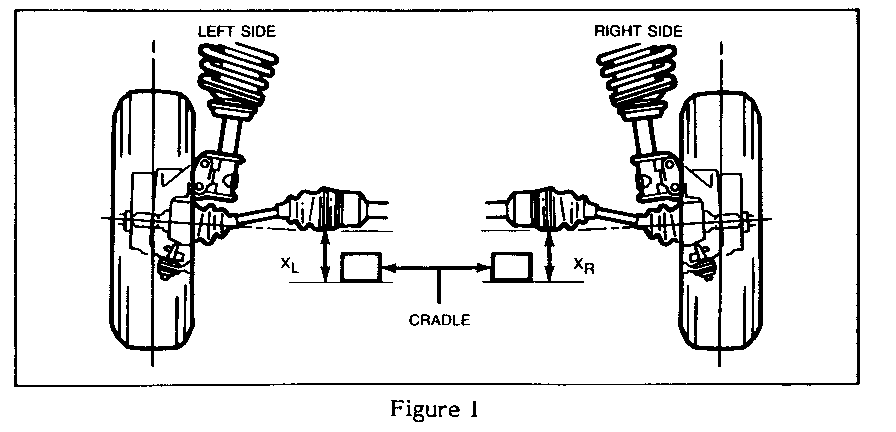TORQUE STEER ON ACCELERATION SERVICE PROCEDURE OUTLINED

VEHICLES AFFECTED: 1985-87 DEVILLES/FLEETWOODS (C) AND 1986-87 ELDORADOS (EO AND SEVILLES(K)
Some 1985-87 DeVilles, Fleetwoods and 1986-87 Eldorados and Sevilles may experience slight torque steer during acceleration. This condition may be caused by the engine and transaxle not being aligned properly in the cradle, resulting in improper drive axle operating angles.
To repair this condition, follow the service procedures listed below:
PRELIMINARY INSPECTIONS
1. Inspect cradle and suspension components for damage or misalignment.
2. Inspect front brakes for binding calipers or sticking caliper pistons.(Refer to Section 5B in the appropriate Service Information Manual.)
3. Verify that front end alignment, tire inflation and trim height are within specifications.
4. Inspect drive axles for damage and/or binding.
REPAIR PROCEDURE
5. Neutralize the engine and transaxle by loosening the engine / transaxle to cradle mounts and allowing the assembly to settle. Retorque the engine and transaxle mounts.
If the above operations fail to repair the torque steer condition, it will be necessary to check and repair drive axle operating angles as follows.
6. Place vehicle on level surface (ie., alignment rack).
7. Measure from inboard constant velocity boot retainer on either side to the lowest point of the cradle assembly and record the measurement "X" (Refer to Figure 1). Repeat the procedure for the other side.
8. E/K - If a side-to-side difference of 1/16" or more is noted, shim the engine and transaxle between the mounts, and cradle to achieve equal drive axle joint heights. Standard body or front end shims may be used. If excessive shimming is required (more than 1/2"), re-inspect for damaged suspension components and proper cradle to body mounting.
C - If a side-to-side difference of 5mm (3/16") or more is noted, shim the engine and transaxle between the mounts and cradle to achieve equal drive axle joint heights. The finish measurement X(R) should be 5mm greater than the finish measurement X(L) (Refer to Figure 1). Standard body or front end shims may be used. If excessive shimming is required (more than 1/2"), re-inspect for damaged suspension components and proper cradle to body mounting.
NOTICE: 1986 AND 1987 DEVILLES AND FLEETWOODS HAVE A FACTORY INSTALLED SHIM AT THE RIGHT SIDE ENGINE MOUNT AND RIGHT SIDE TRANSAXLE MOUNT. DO NOT REMOVE THESE SHIMS WHEN TRYING TO REPAIR THE TORQUE STEER CONDITION. THESE SHIMS ARE TO ENSURE SUFFICIENT OPERATING CLEARANCE FOR THE AIR CONDITIONING COMPRESSOR.

General Motors bulletins are intended for use by professional technicians, not a "do-it-yourselfer". They are written to inform those technicians of conditions that may occur on some vehicles, or to provide information that could assist in the proper service of a vehicle. Properly trained technicians have the equipment, tools, safety instructions and know-how to do a job properly and safely. If a condition is described, do not assume that the bulletin applies to your vehicle, or that your vehicle will have that condition. See a General Motors dealer servicing your brand of General Motors vehicle for information on whether your vehicle may benefit from the information.
